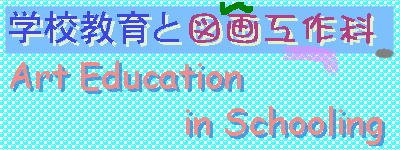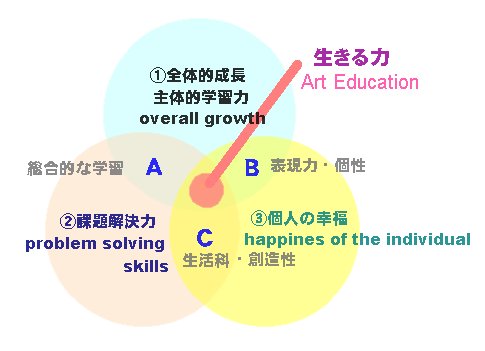

 |
○教育基本法[1947]では
○ By Fundamental Law of Education [1947]
教育の目的(第一条)『教育は人格の完成をめざし、平和的な国家及び社会の形成者として、真理と正義を愛し、個人の価値を尊び、勤労と責任を重んじ、自主的精神にみちた心身ともに健康な国民の育成を期して行われなければならない』と定めている。
The purpose of the education ( Article 1 )
The " Education aims for the character to be complete.Education aims
at the peaceful country and the person who can make society.Education aims
at the person who loves a truth and justice.Education aims at the person
who makes the value of the individual important.Education aims at the person
who thinks much of its work and responsibility.Education aims at an independent
mind and aims to bring up a person with heart and together healthy body."
are being described.
*この英訳は文部省の公式の翻訳ではありません。
*This English translation is not the formal translation of the Ministry
of Education.
Ⅰ 教育課程審議会の提言 1997/11
教育課程の基準の改善の基本方向について (中間まとめより)
『幼児児童生徒の人間として調和のとれた成長を目指し、国家及び社会の形成者として心身ともに健全で、21世紀を主体的に生きることができる国民の育成を期すると』いう観点に立って検討を行った。
○人間として調和のとれた成長 ○21世紀を主体的に生きることのできる国民
○国家及び社会の形成者として心身ともに健全
ここで目指しているのは、知識・記憶の学力ではない。自ら考える力や、判断力・感性さらには、実践力などを含めた豊かな人間的な学力を成長としてとらえている。そのためには、今までのような詰め込み学習ではなく、自分が身をもって経験する学習体験が大切になってくる。
児童自らが情報を集めたり、学んだことを再構成したり、そこに経験を統合するような体験学習が、これからの21世紀を主体的に生きることができる国民の育成には欠かせないだろう。
平成8年7月に出された中央教育審議会第一次答申「21世紀を展望した我が国の教育の在り方について」では、
『変化の激しいこれからの社会において[ゆとり]の中で[生きる力]をはぐくむことを重視すること』を提言している。この体験することで
この[生きる力]について、同答申は「これからの子どもたちに必要となるのは、いかに社会が変化しようと、自分で課題を見つけ、自ら学び、自ら考え、主体的に判断し、行動し、よりよく問題を解決する資質や能力であり、また、他人とともに協調し、他人を思いやる心や感動する心など、豊かな人間性であると考えた。たくましく生きるための健康や体力が不可欠であることは言うまでもない」と述べている。
[生きる力]の分析
①社会の変化への対応力
自ら学び、主体的に判断し、行動し、よりよく問題を解決する資質や能力
②豊かな人間性
自らを律しつつ、自他との協調、おもいやり
③たくましく生きるための健康や体力
学校・家庭・地域社会におけるバランスのとれた教育を通してはぐくむ
子どもたちが主体的に使える自分の時間を増やして[ゆとり]を確保する
また、同答申は、
「[生きる力]は、単に学校だけで育成されるものでなく、学校・家庭・地域社会におけるバランスのとれた教育を通してはぐくまれる」、「家庭や地域社会での生活時間の比重を増やし、子どもたちが主体的に使える自分の時間を増やして[ゆとり]を確保することは、今日、子どもたちにとって極めて重要なことと考える」として、完全学校週5日制の導入を提言している。
そして、完全学校週5日制の下で、[ゆとり]のある教育課程を編成し、[生きる力]を育成するためには、教育内容の厳選が是非とも必要であるとしている。
○ I consider "3 Living Powers "
教育は人格の完成をめざし、平和的な国家及び社会の形成者として、真理と正義を愛し、個人の価値を尊び、勤労と責任を重んじ、自主的精神にみちた心身ともに健康な国民の育成を期して行われなければならない。
| ①全体的成長と人格の完成 The overall growth and virtuous growth 豊かな人間性 |
②社会の形成力と責任感の育成 The problem solving skills ①社会の変化への対応力 |
③個人の幸福と心身の健康 The happiness of the individual ③たくましく生きるための健康や体力 |
| 自ら学習して生きる力(開発力) The power which lives, learning by myself. ( The development ) HUMAN & MENTAL GROWTH 学習力・発展力 ・自ら課題を見つけ、自ら学び、自ら考え、主体的に判断し。学びかたやものの考えかたを身に付けること。 I find the problem personally and learn it personally and think of it personally and judge independently. It acquire the way of learning and thinking of anything. *「総合的な学習の時間」のねらいより。 * From the aim in " the time of the synthetic learning " |
社会や環境で生きる力(対応力) The power which lives in the society and the environment ( The correspondence ) NATURAL & SOCIAL CORRESPONDENCE 対応力・実践力 ・よりよく問題を解決する資質や能力を育てる。 It nourish the attiyude and the ability which solves a problem better. *「総合的な学習の時間」のねらいより。 * From the aim in " the time of the synthetic learning " |
自分らしく生きる力(人生力) The power which seems to be myself and lives. ( The life ) INDIVIDUAL & HEALTHY HAPPINESS 充実力・体力 ・自己の生き方を考えることができる。 It deepen feeling about the way of self's growing. *「総合的な学習の時間」のねらいより。 * From the aim in " the time of the synthetic learning " |
| *教育課程審議会の「総合的な学習の時間」の創設 *Newly founded "Period for Integrated Study" 総合的な学習の時間においては,次のようなねらいをもって指導を行うものとする。 (1) 自ら課題を見付け,自ら学び,自ら考え,主体的に判断し,よりよく問題を解決する資質や能力を育てること。 (2) 学び方やものの考え方を身に付け,問題の解決や探究活動に主体的,創造的に取り組む態度を育て,自己の生き方を考えることができるようにすること。 「学習活動例」 " Learning activity example " ○国際理解・情報・環境・福祉・健康○児童生徒の興味・感心に基づく課題○地域や学校の特色に応じた課題。 ○The international understanding, the information, the environment, the welfare and the health. ○The interest of the child student and the admirably based problem. ○The problem according to the characteristic of the area and the school. | ||
Course of Elementary School Study (Art Education) *表現及び鑑賞の活動を通して、つくりだす喜びを味わうようにするとともに造形的な創造活動の基礎的な能力を育て、豊かな情操を養う。 ART EDUCATION Article 7 TEACHING GOAL No. 1 *Through art expression and art appreciation activities, art education can enable students to experience the joy of making art; develop a fundamental creative ability to form art; and cultivate and instill an aesthetic attitude to appreciate art. 英訳 by Mrs.Otsu | ||
| 1,表現力・基礎的な能力。豊かな情操 The expressive power and the basic ability. The sentiment |
2,創造力(課題解決力) The creative power ( The problem solution power ) |
3,個性・鑑賞力・つくる、生きる喜び The personality. The appreciative power. The living pleasure |
| 図画工作科の目標分析 | 観点 |
| ③生きる楽しさと充足(生きる価値) | 楽しい造形活動 A自分を表し、自分らしさを生かす楽しさ Bモノをつくったり、完成する楽しさ C新しく創造して生み出す楽しさ D材料や用具に触れ、体験する楽しさ E協力して制作する楽しさ F作品や活動を見たり、発表する楽しさ |
| ①人間の全体的発達(調和的な発展) | 頭と心と体(手)の総合 美的情操 D体験学習、触れあい学習 Eグループ学習、コミュニケーション能力 Fプレゼンテーション能力 ITの基礎、マルチメディアの利用 |
| ②創造性の育成(場面での対応) | C主体的創造的に取り組み、課題を解決する能力 D手や用具の使い方の工夫や技能の発達 C情報の収集と活用能力 |
| ①造形能力の基礎 | 色や形の取り扱い方や造形感覚 イメージや対象をスケッチする力 発想力・構想力 企画から制作、使用までのデザイン能力 工作の能力 想像力 正しい用具の使い方 コンピュータでの造形能力 関心を持って作品を見る |
| ①表現力の涵養(教科の総合) | A自己表現力 A体験や想像、学習してきたことをまとめて伝える能力 各教科で習得した知識、思考力、判断力、技能、態度などを関連づける能力 表したいことを効果的に表現する力 Dマルチメディアの表現力(デジタルコミュニケーション) |
| ②文化の継承と創造(視点の拡大と相互理解) | 鑑賞能力 地域文化や日本文化の尊重と改革。 F異文化の学習と理解 新しい文化の創造 |
| ②社会の適応と環境の保持(社会との統合) | A社会生活への適応 C社会的な問題への対応力 地球環境デザイン |
〔参考〕図画工作科の活動課題 筑波大学附属小学校研究紀要 Vol.55
1999 P79~91
①造形表現活動の快さや楽しさを経験する。②自分らしさを、或いは造形的課題を追求、発見したり、自己表現する。③造形的なものの見方や考え方を養い、造形感覚や感性を培う。④総合的な造形表現活動を経験し、総合力を養う。⑤造形表現活動をとおして相互理解、人間理解を図る。⑥造形的な知識や技能を養い、造形文化や歴史に興味や関心を持つ。
○統合する、主要な教育としての美術教育
Arts as A Unifying Principle Education
美術教育は児童の経験と知識(表現力)・理論と実践(問題解決力)・想像と実際(創造力)・自分らしさと適応(個性)などを統一する、重要な基礎教育である。
The art education is the important basis education which unifies the experience
of the child, and knowledge ( the expressive power ) and theory, and practice
( the problem solving power ) and imagination, and a fact ( the creative
power ) and the seeming of doing it being and adaptation ( the personality
) and so on.
それは、自分で触れ、跡が感覚と現実に残る行為として「生きている実感(存在感)」を基底にしながら―、自らを表現することで一人一人に「生きる喜び(自己表現)」を感じさせていく。 そして、児童が材料や用具を使って創る試行錯誤の経験は、将来にわたり、その子なりの「生きる方法や道」を形成する技となっていく。
To make is the act to touch by myself and for a trace to be left in my
sense and actuality.
Therefore, "-The fruit sense that we lives- the existence sense to
live" can be felt.
To create makes feel apiece "living pleasure-self expression -"
in expressing myself.
Moreover, the experience of the trial and error which the child makes using
the material and the instrument becomes the skill which forms "the
way and the road to live" which is the child for the future.
一方では、文化の伝承として、用具の基礎的技能の学習や作品鑑賞などを通じて、様々な国の「生きる手だて」の方法を現実に習得したり、理解していくことができる。そして、児童は知識だけではなく、実際的に制作したり、行動する中で美や善について自ら判断していく力をはぐくんでいく。そのような図画工作科の総合的な学習が、地球環境や国際社会に対応して、「主体的で美的に生きる力」を実践的に身につけさせていく。
On the other hand, various country " Living plan " way can be
actually acquired through the learning of the basic skill of the instrument
and the work appreciation and so on as cultural transfer and be understood.
Then, the child cultivates the power to judge personally about the beauty
and the goodness in composing practically and in addition to the knowledge
acting.
美術教育において、『生きる力』とはそのまま授業で行っている創造的活動である。そこには、美しいものをすすんでつくろうとする美への志向(思考)や価値の創造が存在している。
In the art education, "the living power" is the creative activity
which goes by the class.
The direction to the beauty.
There is creation of the value when advanced in beautiful one and trying
to make aesthetic consideration.
それは、知識ではなく―、社会や人生などを領域にした、総合的なデザイン学習【DESIGNING】として、未来をつくる体験学習であり―貴重な総合的学習である。
The synthetic design learning which is not knowledge and make society and
life area【DESIGNING】. It is the experience learning which is formed into
the future and is valuable synthetic learning.
Written by Makio Kawashima
Last updated on 1/24/2021
![]() 小学校図画工作科
The Home Page of Art Education
小学校図画工作科
The Home Page of Art Education
![]() 総合的な学習 Synthetic
Learning
総合的な学習 Synthetic
Learning
![]() 図画工作科の生きる力・マルチメディア工作 The
Value of Art Education
図画工作科の生きる力・マルチメディア工作 The
Value of Art Education
![]() 環境学習 Environmental Education Learning
環境学習 Environmental Education Learning